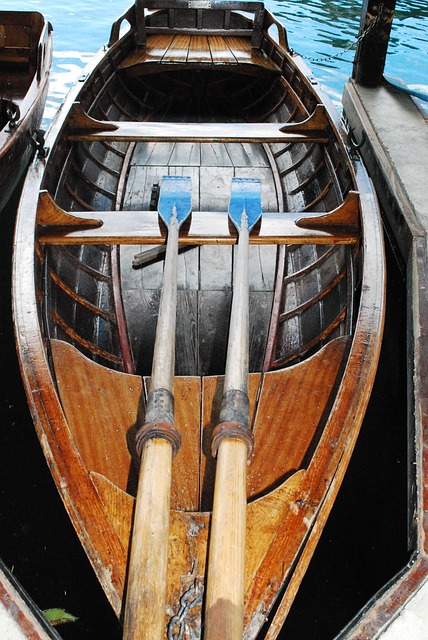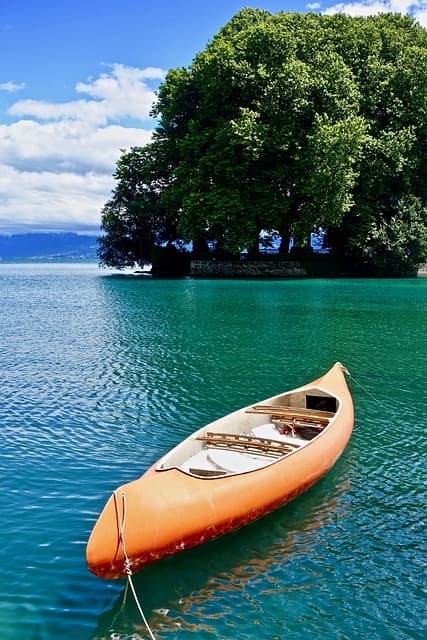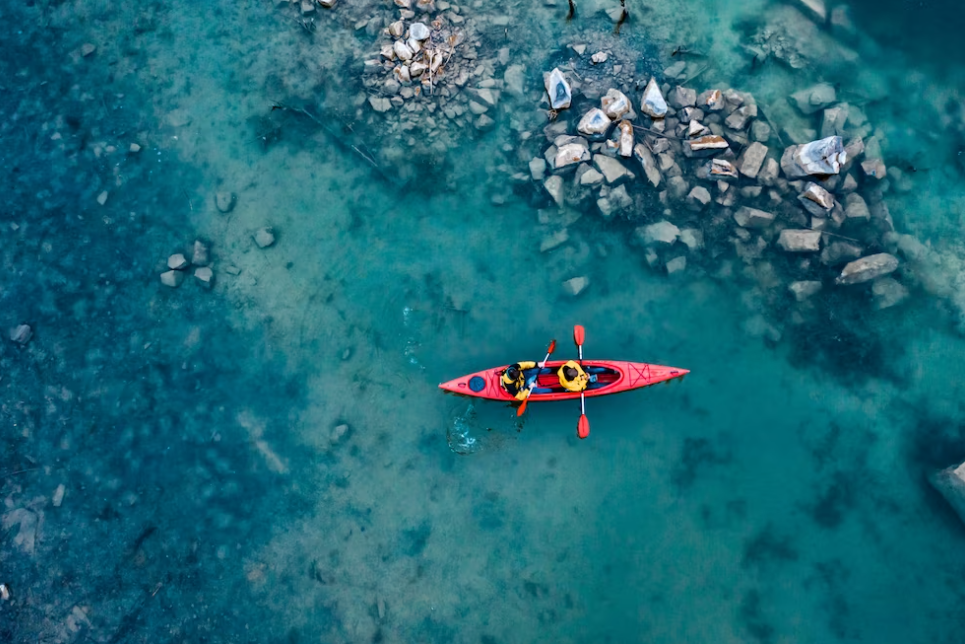Acquiring your inaugural kayak might appear as a formidable endeavor. After a period of renting, the moment to progress has arrived. While they may seem similar at first glance, akin to how your two pet axolotls bear resemblance, there are nuances to explore.
The objective of this piece is to navigate you through your decision-making journey. My intention is to assist you in posing the pertinent inquiries that will distill the vast expanse of kayak varieties into a select few that align best with your preferences.
Assessing Your Past Paddling Adventures
Have you had the opportunity to paddle before? Have you taken a kayak out on the water in the past? If your response is a simple ‘none’, there’s no need to worry. It’s important to gauge your starting point. Alternatively, your last three summers might have been filled with sea kayak rentals for exciting overnight camping escapades. Or maybe you’ve been borrowing a friend’s extra fishing kayak to explore the local river with your group.
However, there’s a pivotal question concerning your prior experiences: ‘Have you ever participated in a kayak lesson?’ Have you mastered techniques like rolling, wet-exits, re-entry, rescues, bracing, and hip-snaps? While some of these skills are specific to certain activities, your answers play a key role in determining the type of kayak that aligns with your needs.
Choosing the Right Kayak for Your Journey
Your first kayak shouldn’t be your last. Becoming proficient in kayaking takes time and practice. The kayak you use to learn basic skills shouldn’t be the same one you use to master intermediate and advanced techniques.
Why is that? Because their characteristics serve different purposes.
- A beginner kayak is designed to offer excellent primary stability (the stability experienced in calm waters), along with easy maneuvering and relatively straight tracking at an efficient touring speed;
- An intermediate or advanced kayak might feel too unstable for a novice paddler. While an advanced kayak can achieve higher speeds, beginners lack the skills and experience to reach those levels.
In fact, the instability of an advanced kayak could impede a beginner’s progress, preventing them from feeling secure even in calm waters.
Avoid the mistake of purchasing a kayak that’s too advanced for your current abilities. Investing in an expensive high-performance kayak too soon might hinder your learning curve.
Once you feel comfortable in your beginner kayak and are ready to challenge yourself with a narrower, less stable design, you can either sell your initial kayak on platforms like Craigslist or keep it for playful activities in waves.
What Kind of Kayaking Are You Planning and Where Will You Be?
The type of kayaking you have in mind and the environments you intend to explore play a crucial role in determining the most suitable kayak style for you.
Tranquil, Shallow Rivers
If your kayaking expeditions are focused on leisurely journeys along calm, shallow rivers that hug the banks and allow you to stand up, you’re in for a versatile range of options.
In other words, your performance demands are relatively undemanding, providing you with a broad spectrum of kayak choices.
Sit-on-Top vs. Sit-In
For relaxed river kayaking, either a recreational sit-on-top or a sit-in kayak can be ideal. To recap, sit-on-top kayaks feature an open cockpit design that leaves your legs and feet exposed to the sky. The advantage of sit-on-top kayaks is their safety. Fitted with scupper holes to drain water, they are nearly unsinkable.
However, these kayaks sacrifice performance. Maneuvers like rolling, bracing, and hip-snapping aren’t as effective in a sit-on-top kayak. While they offer an accessible way onto the water, you won’t be able to learn all the paddle skills you might desire in one.
Sit-on-top kayaks can be a great choice for beginners who prioritize safety and ease of use over performance. On average, the recreational sit-on-top kayaks in my database weigh 58 lbs, have a length of 11.5′, and are 30″ wide. Conversely, sit-in kayaks feature a closed cockpit design where your legs and feet are enclosed within the kayak’s deck. Some sit-in kayaks are tailored for beginners, while others are designed for advanced performance.
For novice paddlers, opting for a sit-in kayak offers advantages like improved paddle skill development. Thanks to the inclusion of hip support and knee braces, paddlers can learn and practice techniques such as leaning, edging, bracing, hip-snapping, and rolling. While not completely immune to sinking like sit-on-tops, high-quality sit-inside kayaks come equipped with airtight storage hatches at the bow and stern. These compartments ensure that sit-in kayaks remain buoyant enough to expel water from the cockpit using a bilge pump. If your goal is to advance your kayaking skills, a sit-in kayak will provide a more effective platform for skill enhancement compared to a sit-on-top kayak.
On average, the recreational sit-inside kayak in my database weighs 48.75 lbs, is 12.5′ in length, and measures 26.75″ wide. (Note that sit-insides are approximately 10 lbs lighter than sit-on-tops, on average.)
Inflatable or Hardshell: Choosing Your Kayak Type
The next decision to consider is whether to choose an inflatable or hardshell kayak. Inflatable kayaks are constructed using materials like plastic, PVC, and occasionally fabric. They incorporate multiple air-filled chambers to ensure buoyancy and increased rigidity. For beginners, inflatable kayaks offer convenience as they can be compactly folded and easily transported, fitting neatly even on a shelf in a bedroom closet.
However, their performance might come with limitations. If your goal is to significantly enhance your kayaking skills, inflatable kayaks could potentially hinder your progress. Despite ongoing improvements, they tend to remain too flexible for refining techniques such as edging, bracing, rolling, and hip-snapping. Nevertheless, the performance of inflatable kayaks is getting better each year. If your primary focus isn’t on high-intensity kayaking, they can still present a viable alternative.
On average, the inflatable kayaks in my database weigh 63.25 lbs, have a length of 12.6′, and are 29.6″ wide. In contrast, hardshell kayaks are crafted from rigid materials such as plastic, carbon fiber (Kevlar), fiberglass, and even wood. Their designs are aimed at maintaining rigidity when encountering waves, debris, or other kayaks.
- A significant advantage of hardshell kayaks is their capacity to facilitate learning the full range of kayak skills that inflatables or sit-on-tops might hinder;
- Additionally, if the hull sustains damage, a hardshell retains its shape, unlike inflatable kayaks that can resemble a deflating magic carpet;
- On the downside, transporting and storing a rigid kayak can be a hassle.
Storing a hardshell kayak demands significant space, and strapping it onto a vehicle’s roof can result in a distinctive appearance reminiscent of a Parasaurolophus. In a slow, meandering river environment, both inflatable and hardshell kayaks suit a beginner paddler well. While my inclination leans toward hardshell kayaks (due to their potential for skill development), I believe inflatable kayaks are most suited for leisurely river outings.
Additional Kayak Characteristics for Lazy Rivers
| Characteristic | Recommendations for Beginners |
|---|---|
| Length | Aim for 10-12′ for optimal maneuverability. Longer kayaks, such as 16′, are excessive for tranquil rivers and can pose challenges for beginners when navigating bends and obstacles. |
| Width | Opt for wider kayaks, around 30″ or more, to provide improved primary stability, which is beneficial for novice kayakers. |
Navigating Active Rivers with Waves and Rapids
To begin, if you’re new to kayaking and have limited experience, venturing into whitewater river runs might not be the wisest choice. However, if you possess basic paddling skills and are eager to delve into kayaking in whitewater environments, let’s delve into the topic.
River kayaks are designed to offer optimal control amid tumultuous waters. They’re characterized by their short length, relatively light weight, and sturdy hulls (which, fair warning, won’t remain unscathed for long). Whitewater kayaking is generally divided into three categories:
- Creeking;
- River Running;
- River Play/Rodeo.
Creeking
Creeking involves navigating steep, low-volume whitewater. If you’re a beginner, getting closer to creeking should be a distant consideration at this point.
River Running
River running entails paddling through higher-volume whitewater rapids, reflecting the more traditional aspect of the sport.
River Play/Rodeo
River play involves executing tricks within rapids using your kayak. While the optimal kayak attributes vary slightly across these activities, there are also shared characteristics.
River Kayak Hull Types
River kayaks can be categorized into two primary hull styles: Planing hull and Displacement hull. Planing hulls are characterized by a flat bottom that extends from edge to edge. These kayaks exhibit exceptional agility and maneuverability in white water conditions. They excel when propelled by the river’s current, but they may not be particularly fast when you need to generate your own momentum on flat water. Planing hulls are commonly used across all three segments of whitewater kayaking, especially in River Play scenarios.
On the other hand, Displacement hulls feature a rounder bottom that displaces water to the sides, enabling the kayaker to glide through flat water more smoothly and swiftly. When navigating river rapids, displacement hulls maintain a good degree of agility, albeit less than planing hulls. While initial stability on displacement hulls can initially feel slightly uncertain, secondary stability becomes more pronounced as you navigate the rapids and encounter bouncing movements.
River Kayak Chine Styles
Chines are the submerged portion of a kayak’s hull, significantly influencing its handling. Hard chines manifest as pronounced, rigid contours beneath the waterline. While they offer control and agility in calmer waters, hard chines can become quite grippy in intense rapids or other river features, making kayak control more challenging. Soft chines, featuring a rounded hull, are more forgiving than their hard counterparts. They provide increased stability but demand more effort to propel in flatter waters.
River Kayak Rocker
Rocker pertains to the curvature of a kayak from its bow to stern. A higher rocker translates to increased agility and maneuverability, particularly in the hands of experienced paddlers. Conversely, less rocker enhances a kayak’s capacity for speed and maintaining a straight course. For those new to river kayaking, it’s advisable to opt for a displacement-hull kayak featuring soft chines and moderate rocker. This choice provides a balance of stability and maneuverability.
Starting with such a kayak, you can progress to a hybrid design that features a slightly rounded hull, a subtle flatness, and slightly firmer chines. As your skills evolve, the next step could involve transitioning to a play-boat, a compact kayak measuring around 5-6′ in length. These play-boats are equipped with a flat planing hull and hard chines, optimized for advanced maneuvers and tricks.
On average, the whitewater kayaks in my database, which encompass Creeking, River Running, and River Play boats, have dimensions of approximately 8.5′ in length, 25.6″ in width, and a weight of 42.25 lbs.
Coastal and Oceanic Environments: Navigating with Prudence
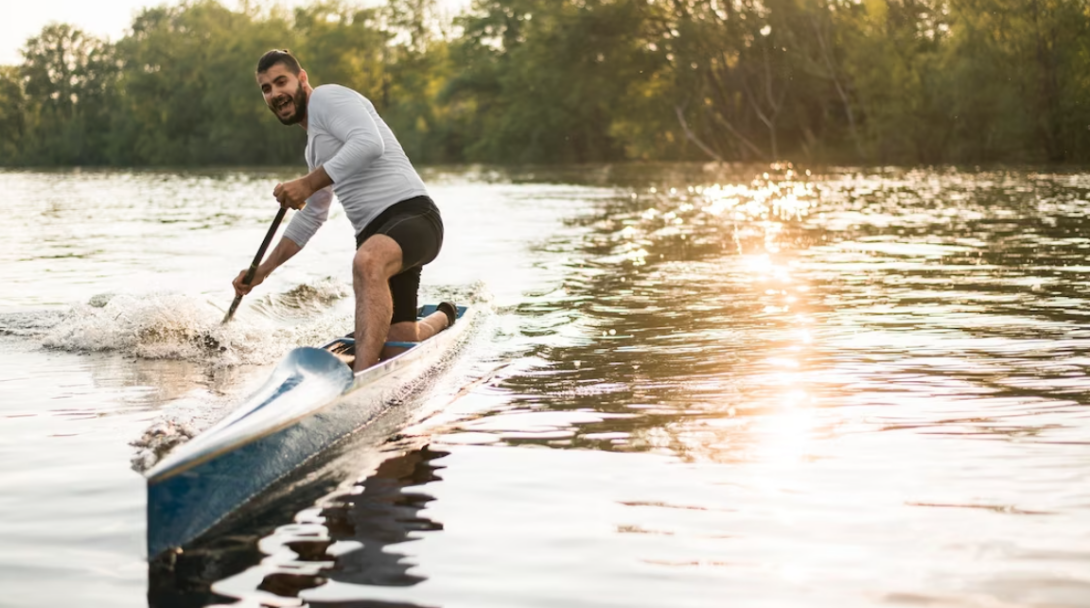
First and foremost, it’s highly recommended to undertake a few lessons and gain experience in shallower waters before venturing into the open sea. Deep waters with currents, winds, and waves bring elevated risks with minimal room for errors. Due to these high stakes, newcomers often fall into the trap of acquiring kayaks that exceed their novice abilities.
Once they’re out on the ocean, their discomfort becomes evident even in calm waters. Avoid this mistake. For coastal and ocean settings, touring kayaks are the unequivocal choice. Generally, kayaks labeled as Recreational are unsuitable for these conditions. Here are essential considerations when selecting your initial touring kayak:
Seaworthiness
Is the kayak designed to remain afloat even under extreme circumstances? Does it feature bow and stern hatches to prevent sinking, even if it becomes swamped? If a kayak you’re considering only offers a watertight hatch at the stern, it’s inadequate and not suitable for ocean use.
Body Fit
Does the kayak conform to your body? Comfort during prolonged seating is crucial. Spending hours in your touring kayak with discomfort could lead to major discomfort during extended paddling sessions. If the fit isn’t right, move on.
Primary Stability
Primary stability indicates the initial stability on calm waters. Kayaks with wider hulls generally boast higher primary stability. Novice paddlers benefit from this while learning to paddle in calm waters.
Over time, as you progress to choppier waters, you’ll require the higher secondary stability provided by more intermediate and advanced kayaks.
Kayak Seating
Once again, comfort and fit are paramount. If the kayak’s seat is uncomfortable or ill-fitting, consider an alternative seat or kayak. An effective kayak seat isn’t overly elevated, as tall seats hinder efficient paddling technique and make entry and re-entry cumbersome.
Seats with hip support and cockpits featuring knee braces will aid in mastering techniques like rolling, hip-snapping, bracing, leaning, and edging.
Kayak Length
Touring kayaks below 12-13′ may feel sluggish, while those exceeding 17′ can prove challenging for inexperienced paddlers to maneuver. While longer kayaks generally offer higher top speeds, attaining those speeds requires significant strength and fitness.
For beginning paddlers, a touring kayak of around 14-15′ strikes a balance between primary stability, efficient touring speed, and maneuverability.
On average, the polyethylene touring kayak in my database measures 15.4′ in length, 23″ in width, and weighs 52.4 lbs. The average composite kayak is 17.6′ long, 21.6″ wide, and weighs 50.8 lbs (long, slender, lightweight, and pricey).
Materials (and Price)
Touring kayaks are commonly crafted from polyethylene, fiberglass, or composites like Kevlar. They feature rigid, hardshell constructions. The most expensive kayaks, resembling sleek projectiles, are fashioned from fiberglass or Kevlar. These boats are light, narrow, and swift. While they may resemble elongated, polished instruments, their appeal lies in their aesthetics and advanced handling.
A suitable beginner touring kayak is likely to be constructed from rotomolded polyethylene. It might not be the most visually stunning, but it will effectively enhance your skills and maximize your time on the water.
A Note on Used Kayaks
I wholeheartedly endorse seeking out used kayaks. In fact, I’m so supportive that I’ve dedicated an entire article and created a checklist to guide individuals through the process.
Though it might seem repetitive, it’s worth emphasizing: stumbling upon a fantastic deal for a high-end 17′ fiberglass kayak doesn’t mean you should use it as a platform for learning.
While you can seize the deal and store the kayak until your skills catch up, remember that familiarity with a novice-level kayak and the skillset needed for coastal kayaking’s unique challenges are prerequisites.
Kayak Fishing in Diverse Waters
Acquiring your inaugural fishing kayak is a distinct endeavor. Why? Because the motivations behind anglers purchasing fishing kayaks often diverge from those of paddlers acquiring conventional kayaks.
For paddling enthusiasts, honing skills and becoming proficient paddlers drive their pursuit, embracing the purity of the sport itself. Anglers, on the other hand, often seek a dependable vessel that can transport them to their prime fishing spots. In essence, the paddler’s spiritual experience is tied to kayaking, while the angler’s joy thrives in the act of fishing.
Fishing kayaks are frequently seen as cost-effective alternatives to motorboats, costing thousands of dollars less than their motor-powered counterparts. Moreover, their stealthiness outperforms motorboats, granting access to secluded locations unreachable by larger, noisier, gas-guzzling vessels. Thus, selecting a starting fishing kayak differs from choosing an introductory touring kayak.
The Reality of Beginner Fishing Kayaks
In my dataset, the average fishing kayak measures 104.7 lbs, 12.4′ long, and 36.2″ wide. Length variation isn’t significant, ranging from 10.5′ to 13.5′, while width differences are more pronounced, spanning from 32″ to 41.5″.
However, the real disparities lie in weight. The lightest fishing kayak weighs 63 lbs, contrasting with the heaviest at 178 lbs, intriguingly both products from the same manufacturer.
These differences revolve around width and weight, as broader and heavier kayaks offer more stability, durability, and space for gear. They often feature pedal drives but come at a higher price. When acquiring a beginner fishing kayak, your most crucial consideration boils down to your budget.
The Essentials for Your Beginner Fishing Kayak
| Accessory | Description |
|---|---|
| Rod Holders | Ensure secure storage for your fishing rods during paddling, pedaling, and trolling. Choose a kayak deck with ample space for the rod holders you need. |
| Kayak Seat | Whether it’s your first or seventh fishing kayak, comfort is key. Find a seat that aligns with your body and kayak, especially if extended fishing days are in your plans. Remember, higher seating height affects stability; wider kayaks accommodate taller seats. |
| Anchor Rigging | Prevent drifting from your fishing spot by using an anchor trolley. Some kayaks include one, while others require aftermarket installation. This system shuttles the anchor line between bow and stern while you remain seated. |
Other gear you may require includes
- fishing rods;
- a tackle box;
- paddle leash;
- paddle clip;
- fish grip with a scale;
- fish bag;
- electronic fish finder;
- fish finder battery;
- GPS;
- cooler.
When choosing your first fishing kayak, consider your fishing style, preferred locations, and the necessary gear for a successful experience. And of course, factor in your budget to ensure the complete package.
What Weight Should a Beginner Kayak Support?
If you possess a sturdy physique or intend to approach a kayak’s weight limit, this question is pivotal.
The 2/3 Guideline
A rather informal rule-of-thumb is the 2/3 rule, suggesting that a kayak’s effective paddling weight is approximately 2/3 of its stated maximum capacity.
However, there’s a lot of variability in this rule. Manufacturers define weight capacity differently, and the fraction itself isn’t absolute—some advocate for half or three-quarters. The concept of “paddling effectively” also merits clarification.
In essence, the rule underscores the need to maintain a safety buffer between the kayak’s weight capacity and the actual load, enhancing its performance.
Determining How Much of the Kayak Submerges
Here’s a more empirical approach to gauging a kayak’s weight-bearing capability. A kayak laden with weight shouldn’t submerge more than 3.5-4 inches beneath the water. For those willing to embrace a bit of math, you can use the equation below to calculate submersion given a heavy load:
LWL x BWL x Weight x Water Density x Block Coefficient = Sinkage
Consider this example:
- Kayak waterline length (LWL) = 11′;
- Kayak waterline beam (BWL) = 2.85′;
- Weight (kayak, paddler, gear) = 360 lbs;
- Freshwater density;
- 11 x 2.85 x 360 x 62.4 x 0.65 = 0.283 feet (about 3.39 inches).
In this instance, the kayak should float with around 3.39 inches of its hull submerged. (While not a precise calculation, it offers valuable insight into a kayak’s weight tolerance.)
When seeking a beginner kayak, utilize the 2/3 rule and the equation to ensure compliance with maximum weight capacity and submersion below 3.5-4 inches. If calculations indicate exceeding 4 inches, options include choosing a longer/wider kayak, reducing gear, or—jokingly—embracing a “Jenny Craig” solution.
Transportation and Storage of Your New Beginner Kayak
Upon acquiring your first beginner kayak, you’ll need to address both its transportation and storage aspects. For those who opt for an inflatable kayak, it conveniently fits into your car’s trunk and can be stored with ease in various spaces within your home or garage.
However, if you’ve chosen a hardshell kayak, careful consideration is required for its transportation and storage.
Kayak Transportation
Unless you possess a pickup truck or have plans to use public transportation, the typical method of transporting your kayak involves securing it on the roof of your vehicle. Decisions need to be made regarding whether to attach the kayak to foam pads on your crossbars or invest in aftermarket attachments such as J-cradles or stackers.
Kayak Storage
Effective kayak storage is crucial to prevent material deterioration and maintain its structural integrity over time. For hardshell kayaks, more planning is needed to ensure proper storage. In general, storing most hardshell kayaks involves the use of well-padded brackets or suspension through nylon-strap slings.
These supports should be positioned to align with the kayak’s internal bulkheads, as these areas offer the greatest structural strength. For recreational kayaks with larger cockpits, resting the cockpit coaming on storage bars is advisable. The ideal storage location is within a garage or basement. If that’s not feasible, wrapping the kayak in a snug tarp and striving to shield it from direct sunlight and the elements becomes essential.
Don’t Forget to Get a Paddle for Your Kayak
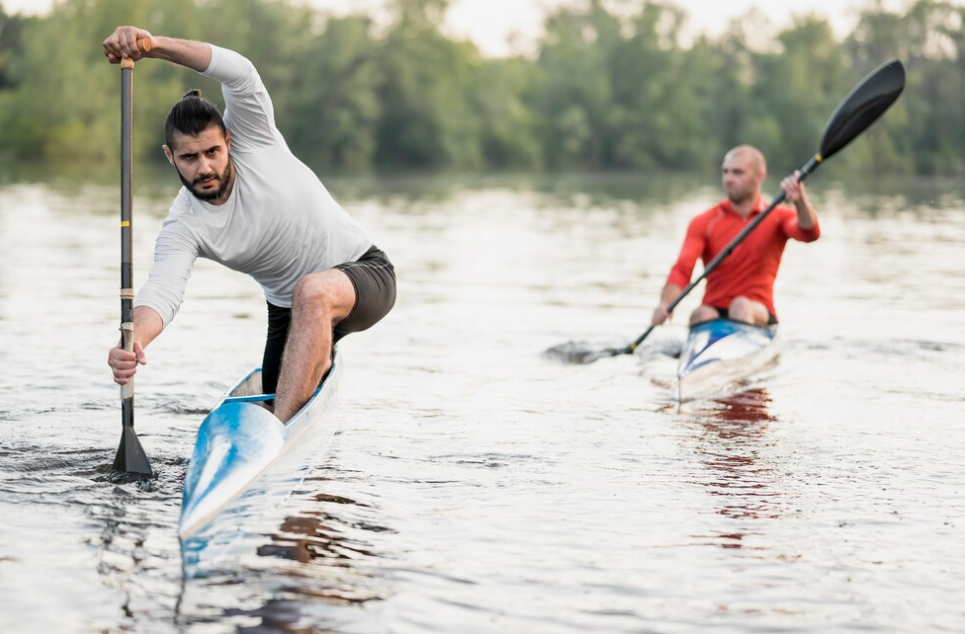
You’ll also need to invest in a paddle. If your choice is a fishing kayak with pedals, a lower-quality, budget-friendly paddle might suffice due to budget constraints. However, for any other type of kayak, it’s wise not to compromise on the quality of your paddle.
Here are some key considerations to keep in mind:
- Paddle Size: Your paddle should be the right size, neither too large nor too small for effective use. Refer to the table below to determine the paddle size that suits you best.
- Paddle Weight: A paddle with a lower swing weight enhances your kayaking experience. However, lighter paddles come at a higher cost.
Given budget limitations, I recommend allocating more funds for a quality paddle and a bit less for the kayak itself.
High-quality paddles are often crafted from fiberglass, carbon fiber, and occasionally, wood. These materials make the paddles buoyant, responsive, and a joy to use.
- Blade and Shaft Design: Kayak paddles come in various blade widths and shapes, each tailored to a specific paddling angle.
Narrow blades suit leisurely, lower-angle paddling, while wider blades are designed for high-angle techniques that demand powerful strokes for swift movement. Paddles come with both straight and bent shafts. Straight shafts resemble a broomstick with blades at each end, while bent shafts incorporate ergonomic bends to enable a more comfortable grip.
Matched and Feathered Blades: Matched paddle blades have a consistent angle along the shaft, ensuring both blades are aligned. Feathered blades are angled differently from each other. When viewing the paddle from above the shaft, one blade is horizontal while the other is inclined at an angle between 15-90 degrees.
When test-paddling kayaks, don’t forget to try out different kayak paddles as well. Determine the paddle configuration that feels most comfortable in your hands.
Conclusion
Purchasing your inaugural kayak might feel overwhelming, but with careful consideration, you can make the right choice. Take into account the type of usage and locations you have in mind. Experiment by test-paddling various kayaks and paddles at a kayak outfitter run by knowledgeable paddling enthusiasts. Identify the kayak that suits your comfort level and skills, and make your purchase from them. Keep in mind that this isn’t your final kayak acquisition; it’s the kayak that’s fitting for your current needs, preparing you for future choices.
